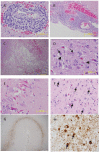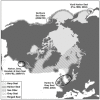Phocine distemper virus: current knowledge and future directions
- PMID: 25533658
- PMCID: PMC4276944
- DOI: 10.3390/v6125093
Phocine distemper virus: current knowledge and future directions
Abstract
Phocine distemper virus (PDV) was first recognized in 1988 following a massive epidemic in harbor and grey seals in north-western Europe. Since then, the epidemiology of infection in North Atlantic and Arctic pinnipeds has been investigated. In the western North Atlantic endemic infection in harp and grey seals predates the European epidemic, with relatively small, localized mortality events occurring primarily in harbor seals. By contrast, PDV seems not to have become established in European harbor seals following the 1988 epidemic and a second event of similar magnitude and extent occurred in 2002. PDV is a distinct species within the Morbillivirus genus with minor sequence variation between outbreaks over time. There is now mounting evidence of PDV-like viruses in the North Pacific/Western Arctic with serological and molecular evidence of infection in pinnipeds and sea otters. However, despite the absence of associated mortality in the region, there is concern that the virus may infect the large Pacific harbor seal and northern elephant seal populations or the endangered Hawaiian monk seals. Here, we review the current state of knowledge on PDV with particular focus on developments in diagnostics, pathogenesis, immune response, vaccine development, phylogenetics and modeling over the past 20 years.
Figures




References
-
- Heide-Jorgensen M.-P., Harkonen T., Dietz R., Thompson P.M. Retrospective of the 1988 European Seal Epizootic. Dis. Aquat. Org. 1992;13:37–62. doi: 10.3354/dao013037. - DOI
Publication types
MeSH terms
LinkOut - more resources
Full Text Sources
Other Literature Sources
Miscellaneous

